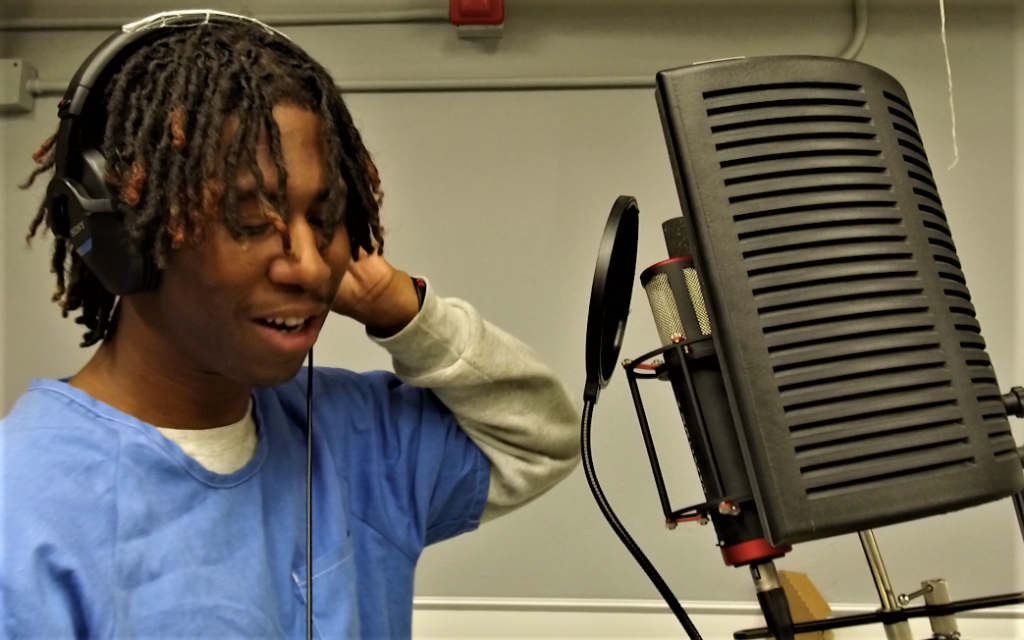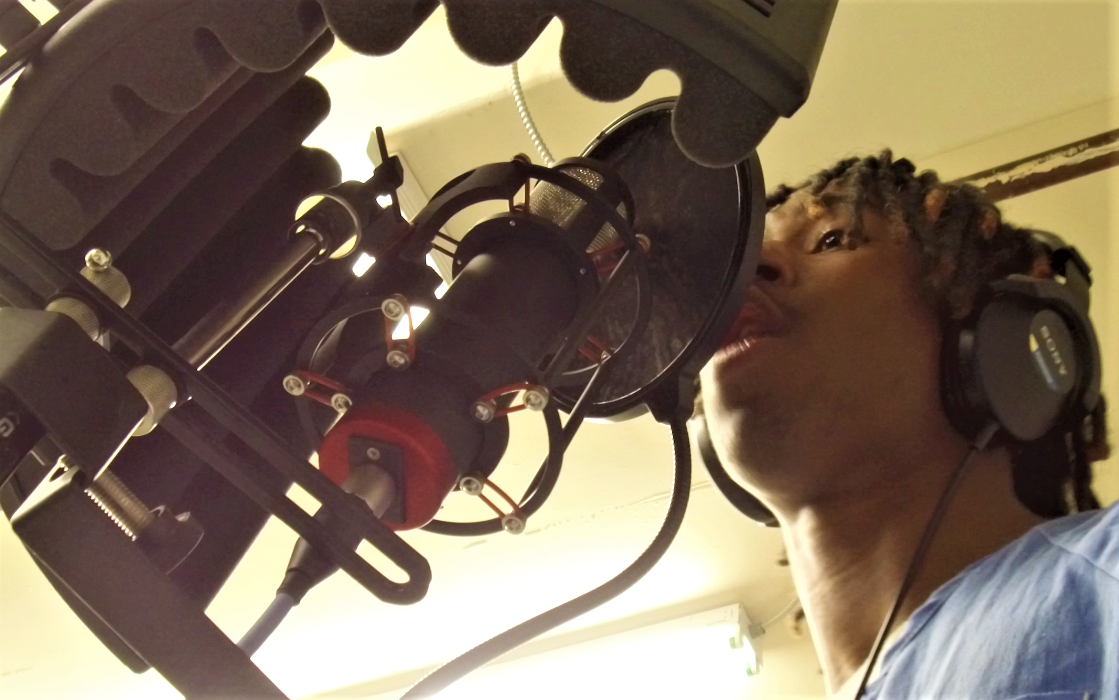San Quentin Mixtapes out now
By Krissi Khokhobashvili, Chief
Office of External Affairs
A musical journey years in the making has finally reached its destination – the San Quentin Mixtapes have arrived.
Featuring the voices of people who came to state prison through the age of 25, the songs share the struggles, hopes, and immense talents of a diverse group of young people, most of whom had never stepped in front of a microphone.
(Download the San Quentin Mixtapes at eqdistro.io/sanquentin_vol1, may not work on a CDCR computer.)
Musical happenstance at San Quentin
“I had a keyboard in my cell,” shared David Jassy, the founder of the Mixtape project. “As I was programming beats, a lot of the youngsters used to be outside of the cell just rapping. And most of the content was pretty explicit.”
As more and more young people started showing up at San Quentin, Jassy, a professional musician, decided to share his talents and incarceration experience to provide a new way for the group outside his cell to express themselves.
“I don’t think I even fully understood what I was trying to do,” Jassy remembered. “I wanted to make a mixtape but I wanted to make a clean mixtape with no curse words, and instead of glorifying the street life, we were warning the younger kids about the criminal lifestyle. And basically have a more insightful rap that can not only prevent crime but actually also serve as rehabilitation for the youthful offenders in San Quentin as well.”
Known for its multitude of rehabilitative programs, thousands of volunteers, and forward-thinking leadership, San Quentin was a natural fit to house people in the Youth Offender Program (YOP) when it was established in 2014. Assembly Bill 1276 required CDCR to allow eligible younger incarcerated people to serve time at lower-level prisons as opposed to higher-security facilities, increasing their access to programs and peers who can share their insight into leading a peaceful life.
Extending SQUIRES program
And so Jassy approached the “Mayor of San Quentin,” Public Information Officer Lt. Sam Robinson, with his idea. He pitched it as an extension of the SQUIRES program, in which at-risk youth spend a day at San Quentin, not to be “scared straight,” but to have meaningful conversations with incarcerated people about their experience and the importance of making positive choices.
“This was another medium that we could then utilize in a different fashion than SQUIRES, but still with the same heart and spirit behind it,” Robinson said. “We would use music, which is definitely attractive to young folks, to sell that same message, that crime doesn’t pay.”
While this was a first-of-its-kind endeavor, luckily San Quentin is known for supporting out-of-the-box initiatives, including the San Quentin News, a newspaper produced entirely by incarcerated journalists, the San Quentin Prison Report radio program, and Ear Hustle, the first-ever podcast from inside a state prison, which has become an international sensation – and for which Jassy contributes music.
Prison staff support
With the support of Warden Ron Davis, Acting Warden Ron Broomfield, and CDCR leadership, Jassy and a crew of youngsters embarked on their project, all under the eye of chief sponsor Raphaele Casale, who works in the Warden’s Office at San Quentin and is heavily involved in many programs, including SQUIRES and the San Quentin Music Program.
“I was able to supervise the project, but I actually was also able to talk to the YOPs, where normally I wouldn’t,” Casale shared. “It put me in that circle and I think they would kind of look at me like who’s this lady over here sitting in the corner? But then they realized that I was supporting them, that I was part of the whole project, and then I was able to give them my two cents and advice and help them, sometimes when they were breaking down. I remember with one musician, he was listening back to the first take of his song and had to take off his headphones and just started crying because he said, ‘I’ve never heard this out loud before.'”
Storytelling is goal
Those breakthroughs and musical storytelling were the whole point of the project for Jassy, who shared that while there was resistance to “clean” rap at first, the musicians in the program quickly got on board.
“These guys in my opinion are credible as far as the story goes,” Jassy said. “The way they tell the narrative is that they really lived the street life and they live the prison life as well, so I think that young youth out there would actually listen to these young men and actually believe what they’re saying and know this is not a fake studio gangster type situation. These are guys that have actually lived this lifestyle and they can tell you straight up and down this is not the place where you want to be, choose a better direction, go to school, college, whatever you want to be.”

Youth is the focus
The focus on youth is at the core of the Mixtapes, which are available across all streaming platforms, including iTunes and Spotify. All proceeds go to charity, and the recipients were thoughtfully chosen to reflect the intention of the project, including the National Center for Victims of Crime (NCVC), which works to help victims, families, and communities rebuild.
“We wanted to definitely keep in mind that there are always victims when it comes to prison and so we wanted to give to NCVC, first and foremost, and to remember that it’s very important to be sensitive to that,” Casale said. “And the YOPs kept that in mind because we would talk about that while they were recoding – that they’re able to give back in a positive way with that in mind.”
Other beneficiaries are the Boys & Girls Club of Oakland and Potrero Hill Neighborhood House, both of which serve youth in need, with an emphasis on education.
Supporters offers resources
As word spread about the project, numerous community members, musicians, and criminal justice reform advocates came forward, providing financial resources, equipment, and their platform to share what was happening inside San Quentin. They included Jessica Jackson and Van Jones of Cut50, Kim Kardashian, J. Cole, Common, Greg Wells, Jamie Lunder, Tom Lapinski, and more.
“San Quentin is just a blessed place and space where a lot of people come in, not only for the San Quentin Mixtape, but they come in to all these different programs,” Jassy said. “I can’t even put it into words how fortunate we were.”
Jassy would find another blessing in this process – in March 2020, his life sentence was commuted by Governor Gavin Newsom due to his extensive involvement in rehabilitation and restorative justice programs, including the Mixtape. He is now in his hometown of Stockholm, Sweden, where he continues to support the Mixtape and looks forward to assisting its artists as they return home, as well.
“I’m fully invested in it, even though I’m back here,” Jassy said. “I have my heart in this project, all the participants in the project became like family to me, I really care about their stories. I’m here for the other guys whenever they get out, whatever they need, I’m still going to be here to support them. I’m fully invested in this.”
